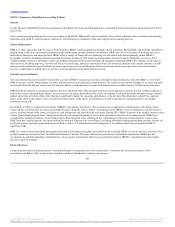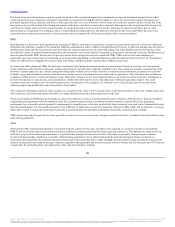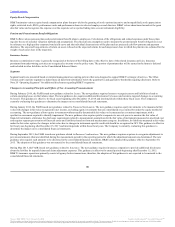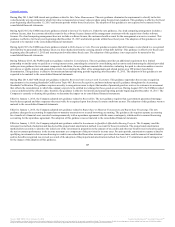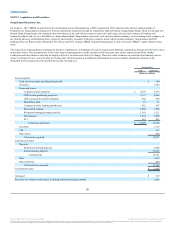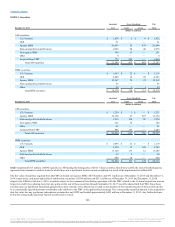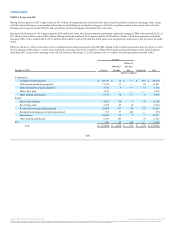BB&T 2015 Annual Report Download - page 106
Download and view the complete annual report
Please find page 106 of the 2015 BB&T annual report below. You can navigate through the pages in the report by either clicking on the pages listed below, or by using the keyword search tool below to find specific information within the annual report.
TableofContents
Derivatives used to manage economic risk not designated as hedges primarily represent economic risk management instruments of MSRs and mortgage
banking operations, with gains or losses included in mortgage banking income. In connection with its mortgage banking activities, BB&T enters into loan
commitments to fund residential mortgage loans at specified rates and for specified periods of time. To the extent that BB&T’s interest rate lock commitments
relate to loans that will be held for sale upon funding, they are also accounted for as derivatives, with gains or losses included in mortgage banking income.
Gains and losses on other derivatives used to manage economic risk are primarily associated with client derivative activity and are included in other income.
Credit risk resulting from derivatives arises when amounts receivable from a counterparty exceed those payable to the same counterparty. The risk of loss
with respect to over-the-counter derivatives, eligible margin loans and repurchase-style transactions is addressed by subjecting counterparties to a credit
review and approval process similar to the process in making loans or other extensions of credit and/or by requiring collateral.
Derivative dealer counterparties operate under agreements to provide cash and/or highly liquid securities on a daily basis for unsecured credit exposure
beyond negotiated limits, while client derivatives that are associated with loans are cross-collateralized with the loan.
BB&T only transacts with dealer counterparties that are national market makers with strong credit standings and requires liquid collateral to secure credit
exposure. Due to these factors, the fair value of derivatives with dealer counterparties is primarily based on the interest rate mark of each trade. The fair value
of interest rate derivatives with clients includes a credit valuation adjustment.
Collateral obtained to secure margin loans includes equities, corporate and municipal securities, and repurchase-style transactions are generally secured by
government and agency securities. The value of collateral for margin loans and repurchase-style transactions is monitored daily with settlement required
when changes in value exceed established limits by counterparty. Due to the liquid nature of collateral, the frequency of transactions and collateral
monitoring, a reserve for credit loss is established only when a risk of loss is identified.
Goodwill and Other Intangible Assets
Goodwill represents the cost in excess of the fair value of net assets acquired (including identifiable intangibles) in transactions accounted for as acquisitions.
BB&T allocates goodwill to the reporting unit(s) that receives significant benefits from the acquisition. Goodwill is tested at least annually for impairment
during the fourth quarter of each year and more frequently if circumstances exist that indicate a possible reduction in the fair value of the business below its
carrying value. BB&T measures impairment using the present value of estimated future cash flows based upon available information. Discount rates are based
upon the cost of capital specific to the industry in which the reporting unit operates. If the carrying value of the reporting unit exceeds its fair value, a second
analysis is performed to measure the fair value of all assets and liabilities. If, based on the second analysis, it is determined that the fair value of the assets and
liabilities of the reporting unit is less than the carrying value, BB&T would recognize impairment for the excess of carrying value over fair value.
CDI and other intangible assets include premiums paid for acquisitions of core deposits and other identifiable intangible assets. Intangible assets other than
goodwill, which are determined to have finite lives, are amortized based upon the estimated economic benefits received.
MSRs
BB&T has two primary classes of MSRs for which it separately manages the economic risks: residential and commercial. Residential MSRs are recorded on
the Consolidated Balance Sheets primarily at fair value with changes in fair value recorded as a component of mortgage banking income. Various derivative
instruments are used to mitigate the income statement effect of changes in fair value due to changes in valuation inputs and assumptions of the residential
MSRs. Commercial MSRs are recorded as other assets on the Consolidated Balance Sheets at the lower of cost or market and are amortized in proportion to,
and over the estimated period, that net servicing income is expected to be received based on projections of the amount and timing of estimated future net
cash flows. The amount and timing of estimated future net cash flows are updated based on actual results and updated projections. BB&T periodically
evaluates its commercial MSRs for impairment.
95
Source: BB&T CORP, 10-K, February 25, 2016 Powered by Morningstar® Document Research℠
The information contained herein may not be copied, adapted or distributed and is not warranted to be accurate, complete or timely. The user assumes all risks for any damages or losses arising from any use of this information,
except to the extent such damages or losses cannot be limited or excluded by applicable law. Past financial performance is no guarantee of future results.




